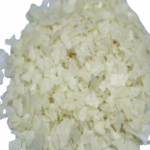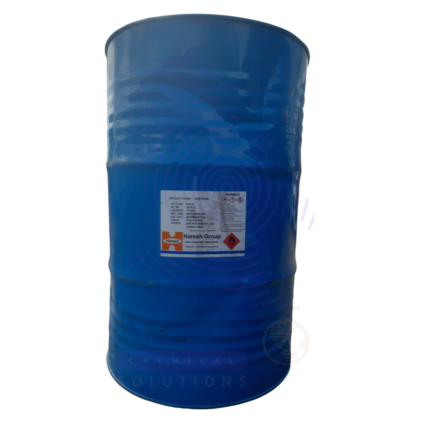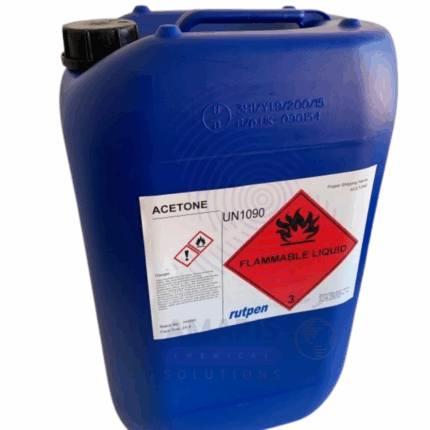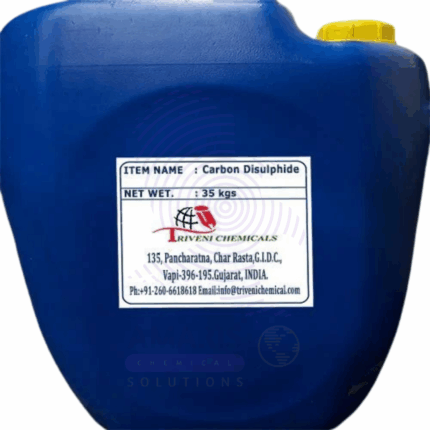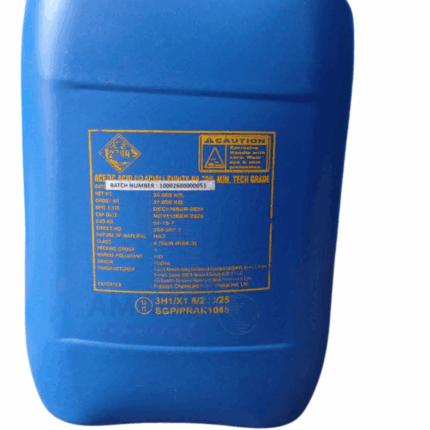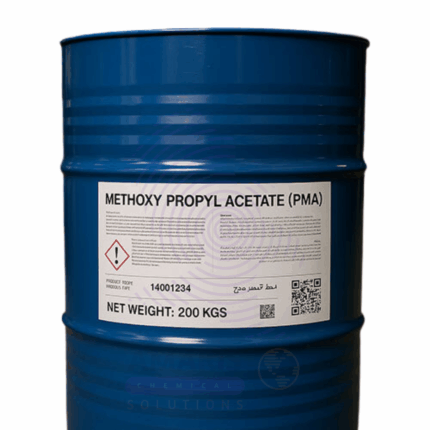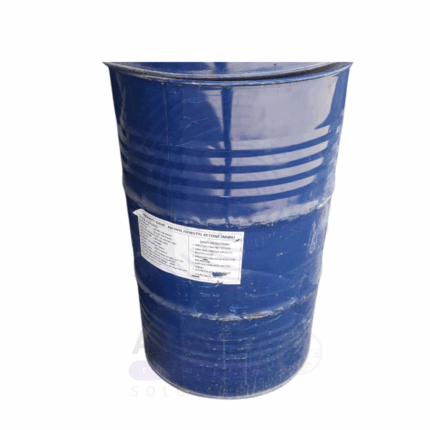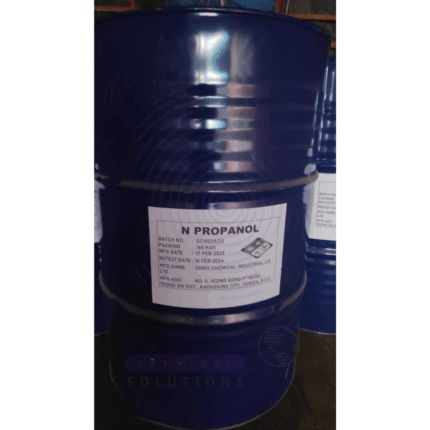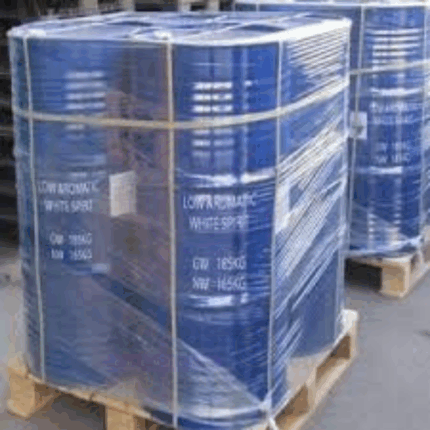Ink reducer (Ethanol)
Whatsapp Order
Ink reducer (Ethanol) is a volatile, colorless liquid used to adjust the viscosity, flow, and drying time of printing inks. Composed primarily of high-purity ethanol (ethyl alcohol), it acts as a solvent or diluent in various ink systems—particularly in flexographic, gravure, and screen printing. This reducer enhances printability by improving ink transfer, leveling, and penetration into substrates. Ink reducers based on ethanol are fast-drying and widely compatible with alcohol-soluble and water-alcohol hybrid inks used in packaging, label printing, and paper conversion industries.
Description
Table of Contents
Toggle
Ink Reducer (Ethanol)
Primary Uses
- Printing Industry
- Viscosity Reduction: Ethanol reduces ink viscosity for improved flow during application, ensuring clean, consistent print output and better ink transfer on high-speed presses.
- Drying Accelerator: Due to its high volatility, ethanol speeds up drying on absorbent substrates such as paper, paperboard, and cardboard, helping prevent smudging or offsetting.
- Ink Formulation Solvent: Serves as a primary or co-solvent in ink formulations for flexographic, gravure, and screen printing, especially in water-alcohol or solvent-based systems.
- Cleaning & Maintenance: Used as a cleaning agent for ink trays, rollers, and screens to dissolve residual inks and prevent clogging or staining of equipment.
- Adhesion Promoter: Enhances ink penetration and adhesion on porous or semi-porous substrates like kraft paper, tissue, and coated board.
- Packaging & Label Printing
- Film & Foil Printing: Ethanol-based reducers help adjust ink properties for fine print definition on flexible substrates like BOPP, PET, and foil laminates.
- Food Packaging Compliance: Frequently used in low-odor, food-safe printing ink systems due to ethanol’s lower toxicity and minimal residue.
Secondary Uses
- Textile & Fabric Printing
- Used to reduce viscosity in textile inks or pigment dispersions for fabric printing applications like banners, flags, and non-woven materials.
- Craft, Art & DIY Applications
- Applied in artist-grade and industrial printing inks for linocut, block printing, and hand-pulled screen printing.
- Used by DIY users to thin alcohol-based inks and for cleaning printing equipment at small scale.
- Electronics Printing
- In niche conductive ink systems, ethanol may serve as a vehicle for silver or carbon-based inks in printed electronics and RFID applications.
KEY PRODUCT FEATURES
1. Basic Identification Attributes
- Chemical Name (IUPAC): Ethanol (ethyl alcohol)
- Common/Trade Name: Ink Reducer (Ethanol)
- CAS Number: 64-17-5
- HS Code: 2207.10.00 (Undenatured ethyl alcohol for industrial use)
- Synonyms: Ethyl alcohol; alcohol solvent; ethanol thinner
2. Physical & Chemical Properties
- Physical State: Liquid
- Color & Odor: Colorless; mild alcoholic odor
- Boiling Point: ~78.5 °C
- Flash Point: 12–13 °C (closed cup)
- Solubility: Miscible with water and most organic solvents
- Evaporation Rate: Fast
- Purity: Typically ≥95% ethanol (industrial or denatured depending on grade)
- Viscosity: Low; suitable for thinning ink systems directly
- VOC Content: High; classified as a volatile organic compound
3. Safety & Hazard Attributes
GHS Classification
- Flammable Liquid – Category 2
- Eye Irritation – Category 2A
- Specific Target Organ Toxicity (single exposure) – Category 3
Toxicity
- Low acute toxicity; ingestion in large amounts is harmful
- Vapor may cause dizziness or irritation with prolonged exposure
Exposure Limits
- OSHA PEL (TWA): 1000 ppm (1900 mg/m³)
- NIOSH REL: 1000 ppm (1900 mg/m³)
4. Storage & Handling Attributes
Storage Conditions
- Store in a cool, well-ventilated, flammable-safe area
- Keep away from ignition sources and direct sunlight
Container Type
- Metal or plastic drums with flame arrestor caps; small-scale containers must be sealed and labeled properly
Shelf Life
- Indefinite under sealed, dry, and stable storage conditions
Handling Precautions
- Ground and bond containers during transfer
- Avoid open flames, sparks, and static discharge
5. Regulatory & Compliance Attributes
- FDA & Food-Contact Approvals: Ethanol is GRAS (Generally Recognized As Safe) for food-packaging inks in regulated concentrations
- REACH Registration: Fully compliant
- VOC Regulations: Subject to VOC limits in printing and coating applications in various regions
- Transportation: Classified as Dangerous Goods under UN1170 (Ethanol)
6. Environmental & Health Impact
- Biodegradability: Fully biodegradable
- Ecotoxicity: Low at typical use concentrations
- Bioaccumulation: Not expected
- Ozone Depletion Potential: None
- Disposal: Must be handled as hazardous waste in bulk quantities; small amounts may be evaporated or diluted under local regulations
SAFETY HANDLING PRECAUTIONS
Safety Handling Precautions
PPE Required
- Safety goggles
- Chemical-resistant gloves (e.g., nitrile)
- Flame-resistant lab coat or apron
- Respiratory protection in poorly ventilated areas
Handling Guidelines
- Use spark-proof tools and explosion-proof electrical equipment
- Ensure proper air circulation during use
- Do not smoke or eat near handling areas
Storage Measures
- Use approved flammable-liquid containers
- Label all containers clearly and store in fire-rated cabinets
First Aid Measures
- Inhalation: Move to fresh air; seek medical help if breathing difficulty occurs
- Skin Contact: Wash affected area with soap and water; remove contaminated clothing
- Eye Contact: Rinse with plenty of water for at least 15 minutes; seek medical advice
- Ingestion: Do not induce vomiting; rinse mouth and seek medical attention immediately
Firefighting Measures
- Fire Hazards: Highly flammable; vapors form explosive mixtures with air
- Extinguishing Media: Use alcohol-resistant foam, dry chemical, or carbon dioxide
- Special Precautions: Use self-contained breathing apparatus and full protective gear
- Explosion Risk: Prevent vapor accumulation; keep away from heat, sparks, and open flames
Related products
Acetone
Acetone Extra Pure is a high-purity grade of acetone (≥99.5%) specifically purified to meet stringent quality standards for laboratory and industrial applications. This volatile, colorless solvent is characterized by its rapid evaporation rate, excellent solvency power, and minimal impurity content, making it suitable for sensitive chemical processes and analytical applications
Carbon Disulfide
Carbon Disulfide (CS₂) is a volatile, flammable, and highly toxic organic solvent composed of carbon and sulfur. At 99% purity, it is a clear to pale yellow liquid with a pungent, sweet, ether-like odor. Carbon Disulfide is produced primarily by the reaction of carbon (charcoal) with sulfur vapors at high temperatures. Due to its excellent solvent properties and reactivity, it is used across multiple industries, including the production of rayon, cellophane, rubber chemicals, and pesticides. Despite its utility, Carbon Disulfide requires careful handling because of its toxicity, flammability, and environmental hazards.
Glacial Acetic Acid Tech grade
Glacial Acetic Acid Tech grade is a clear, colorless liquid with a pungent vinegar-like odor. It is a less refined form of acetic acid primarily used for industrial and technical applications rather than food or pharmaceutical uses. Typically available in concentrations ranging from 80% to glacial (99-100%), it serves as a crucial chemical reagent, solvent, and intermediate in various industrial processes.
Methoxy Propanol Glycol Ether
Methoxy Propanol Glycol Ether, commonly known as PM Glycol Ether, is a clear, colorless liquid with a mild ether-like odor. It belongs to the glycol ether family and is widely used as a solvent in coatings, inks, cleaning products, and industrial applications due to its excellent solvency, low volatility, and favorable evaporation rate. PM Glycol Ether is miscible with water and many organic solvents, making it versatile for a broad range of formulations.
Methoxy Propyl Acetate
Methoxy Propyl Acetate is a clear, colorless liquid solvent with a mild fruity odor. It is an ester derived from methoxy propanol and acetic acid, widely used in coatings, inks, adhesives, and cleaning products due to its excellent solvency, moderate evaporation rate, and good compatibility with various resins. PMA offers low volatility and strong solvency for a broad range of materials, making it ideal for industrial and commercial applications.
Methyl Iso Butyl Ketone
Methyl Iso Butyl Ketone (MIBK) is a clear, colorless liquid with a characteristic sharp, sweet odor. It is a versatile solvent widely used in industrial applications due to its excellent solvency, moderate evaporation rate, and chemical stability. MIBK is commonly utilized in coatings, adhesives, printing inks, and chemical synthesis.
Prop BH N Propanol Technical Grade
Prop BH N Propanol Technical Grade, is a clear, colorless, flammable liquid alcohol used widely as a solvent and intermediate in chemical manufacturing. It has strong solvency properties for oils, resins, and various organic compounds. Due to its moderate evaporation rate and compatibility with water and other solvents, it is valuable in coatings, pharmaceuticals, and industrial cleaning formulations.
White Spirit
White Spirit is a clear, colorless, petroleum-derived solvent widely used in industrial, commercial, and household applications. It is composed primarily of aliphatic and alicyclic hydrocarbons, offering excellent solvency properties, moderate evaporation rate, and low odor varieties. White Spirit serves as a powerful degreaser, paint thinner, and cleaning agent, facilitating effective removal of oils, greases, and paints.


 Preservatives(food)
Preservatives(food) Flavor Enhancers
Flavor Enhancers Acidulants
Acidulants Sweeteners
Sweeteners Antioxidants
Antioxidants Colorants(food)
Colorants(food) Nutraceutical Ingredients (food)
Nutraceutical Ingredients (food) Nutrient Supplements
Nutrient Supplements Emulsifiers
Emulsifiers
 Collectors
Collectors Dust Suppressants
Dust Suppressants Explosives and Blasting Agents
Explosives and Blasting Agents Flocculants and Coagulants
Flocculants and Coagulants Frothers
Frothers Leaching Agents
Leaching Agents pH Modifiers
pH Modifiers Precious Metal Extraction Agents
Precious Metal Extraction Agents
 Antioxidants(plastic)
Antioxidants(plastic) Colorants (Pigments, Dyes)
Colorants (Pigments, Dyes) Fillers and Reinforcements
Fillers and Reinforcements Flame Retardants
Flame Retardants Monomers
Monomers Plasticizers
Plasticizers Polymerization Initiators
Polymerization Initiators Stabilizers (UV, Heat)
Stabilizers (UV, Heat)
 Antifoaming Agents
Antifoaming Agents Chelating Agents
Chelating Agents Coagulants and Flocculants
Coagulants and Flocculants Corrosion Inhibitors
Corrosion Inhibitors Disinfectants and Biocides
Disinfectants and Biocides Oxidizing Agents
Oxidizing Agents pH Adjusters
pH Adjusters Scale Inhibitors( water)
Scale Inhibitors( water)
 Antioxidants(cosmetic)
Antioxidants(cosmetic) Emollients
Emollients Fragrances and Essential Oils
Fragrances and Essential Oils Humectants
Humectants Preservatives
Preservatives Surfactants(cosmetic)
Surfactants(cosmetic) Thickeners
Thickeners UV Filters
UV Filters
 Fertilizers
Fertilizers Soil Conditioners
Soil Conditioners Plant Growth Regulators
Plant Growth Regulators Animal Feed Additives
Animal Feed Additives Biostimulants
Biostimulants Pesticides (Herbicides, Insecticides, Fungicides)
Pesticides (Herbicides, Insecticides, Fungicides)
 Active Pharmaceutical Ingredients (APIs)
Active Pharmaceutical Ingredients (APIs) Excipients
Excipients Solvents(pharmaceutical)
Solvents(pharmaceutical) Antibiotics
Antibiotics Antiseptics and Disinfectants
Antiseptics and Disinfectants Vaccine Adjuvants
Vaccine Adjuvants Nutraceutical Ingredients (pharmaceutical)
Nutraceutical Ingredients (pharmaceutical) Analgesics & Antipyretics
Analgesics & Antipyretics
 Analytical Reagents
Analytical Reagents Solvents(lab)
Solvents(lab) Chromatography Chemicals
Chromatography Chemicals Spectroscopy Reagents
Spectroscopy Reagents microbiology-and-cell-culture-reagents
microbiology-and-cell-culture-reagents Molecular Biology Reagents
Molecular Biology Reagents Biochemical Reagents
Biochemical Reagents Inorganic and Organic Standards
Inorganic and Organic Standards Laboratory Safety Chemicals
Laboratory Safety Chemicals Specialty Laboratory Chemicals(Special Laboratory Equipment)
Specialty Laboratory Chemicals(Special Laboratory Equipment)
 Demulsifiers
Demulsifiers Hydraulic Fracturing Fluids
Hydraulic Fracturing Fluids Scale Inhibitors(oil)
Scale Inhibitors(oil) Surfactants(oil)
Surfactants(oil) Drilling Fluids
Drilling Fluids
 Dyes and Pigments
Dyes and Pigments Bleaching Agents
Bleaching Agents Softening Agents
Softening Agents Finishing Agents
Finishing Agents Antistatic Agents
Antistatic Agents
 Admixtures
Admixtures Waterproofing Agents
Waterproofing Agents Sealants and Adhesives
Sealants and Adhesives Curing Compounds
Curing Compounds Concrete Repair Chemicals
Concrete Repair Chemicals Anti-Corrosion Coatings
Anti-Corrosion Coatings
 Surfactants(cleaning)
Surfactants(cleaning) Builders
Builders Enzymes
Enzymes Solvents (Cleaning)
Solvents (Cleaning) Fragrances
Fragrances
 Electronic Chemicals
Electronic Chemicals Catalysts
Catalysts Lubricants
Lubricants Photographic Chemicals
Photographic Chemicals Refrigerants
Refrigerants Automotive chemicals
Automotive chemicals Pyrotechnic Chemicals
Pyrotechnic Chemicals
 Biodegradable Surfactants
Biodegradable Surfactants Bio-based Solvents
Bio-based Solvents Renewable Polymers
Renewable Polymers Carbon Capture Chemicals
Carbon Capture Chemicals Wastewater Treatment Chemicals
Wastewater Treatment Chemicals
 Pigments
Pigments Solvents(paint)
Solvents(paint) Specialty Coatings
Specialty Coatings Binders/Resins
Binders/Resins Additives
Additives Driers
Driers Anti-Corrosion Agents
Anti-Corrosion Agents Functional Coatings
Functional Coatings Application-Specific Coatings
Application-Specific Coatings
 Fresh Herbs
Fresh Herbs Ground Spices
Ground Spices Whole Spices
Whole Spices Spice Blends
Spice Blends Dried Herbs
Dried Herbs
 Leavening Agents
Leavening Agents Dough Conditioners
Dough Conditioners Flour Treatments
Flour Treatments Fat Replacers
Fat Replacers Decoratives
Decoratives Preservatives(baking)
Preservatives(baking)
 Plasticizers & Softeners
Plasticizers & Softeners Reinforcing Agents
Reinforcing Agents Adhesion Promoters
Adhesion Promoters Vulcanizing Agents
Vulcanizing Agents Antidegradants
Antidegradants Blowing Agents
Blowing Agents Fillers & Extenders
Fillers & Extenders Accelerators & Retarders
Accelerators & Retarders

